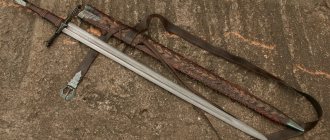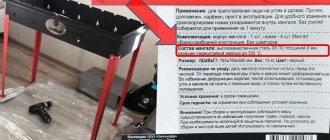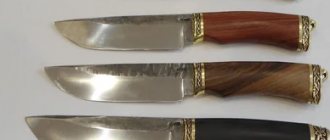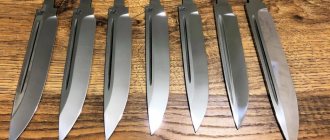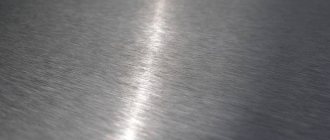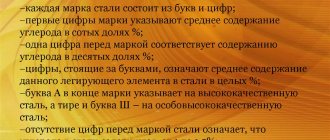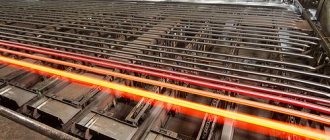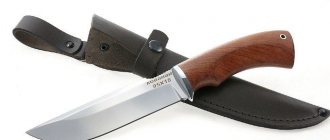What is included in steel
To put it simply, steel is just a mixture of iron and carbon. Moreover, if the alloy contains too much carbon, the result will be cast iron, and if, on the contrary, it contains too little, then the result will be tin. But in the golden mean is steel. Different grades of this metal are determined not so much by the proportions of carbon and iron included in its composition, but by various impurities and additives that have different effects on the behavior of the steel product. Typically, steel contains chromium, carbon, silicon, molybdenum, tungsten, nickel, vanadium, and sulfur in different proportions.
DIY rapid knife
High-speed steel of different grades for knives
The knife consists of two main parts - the blade and the handle. Both parts are important. This article is aimed at the cutting part of the knife. The steel grade plays a vital role in the technical characteristics of the final product. The process of making the blade is no less important.
Rarely do people talk about pre-selection of workpieces. According to knife craft professionals, the mandatory and initial stage is screening out defects. The test is carried out by simply throwing the blanks onto a wooden surface. This must be done several times; products that have succumbed to cracks are rejected.
Finding steel from a high-speed saw in Russia is quite easy. Discarded factory-made products, grandfather had a product from the USSR lying around in his garage, or purchase a new “quick cutter” on the market. Quite suitable options. High-speed steel grades have many suitable varieties for the manufacture of blades.
Steel P18 and knives made from it
Rapid steel P18 is rare. If you are lucky enough to find a saw or a plate, the “knife addicts” cry with envy. Steel with a strength of up to 1000 MPa retains its cutting properties when heated to 600 degrees Celsius. In production they are used for cutting tools: drills, thread cutters, taps, countersinks, reamers and cutters.
Can be forged and hardened. Making a knife from a P18 steel saw is not difficult. Cut out the template, make the slopes, the steering wheel and the handle. No hardening required, no vacation needed. Users have only positive feedback; they have been working with knives for 15-20 years.
A damn good material in terms of strength and durability. The difficulty in sharpening applies to any rapid steel. In this case it is no exception. Afraid of corrosion, requires maintenance.
High-speed steel knives P12
Direct substitute for P18 steel. Industrial application is in drills, taps, reamers and other options. The structure of P12 is close to its “brother” P18. Despite the close similarity, there is a slight difference in mechanical properties.
The heterogeneity of the carbide affects P12 in ductility and toughness. The cutting properties of a blade made of this material are definitely high. Sharpening is slightly easier. Brittleness is characteristic of rapid steels; you should not make a “machete” or an ax. The P18 analogue is perfect for kitchen work.
Steel is quite popular, it is not difficult to find. Used in cutting and sawing tools, copes well with shock loads. There are several varieties according to GOST. Basic rapid properties are present in all grades of R6M5.
Opinions differ on the use of blades made of this material. A dull blade is difficult to sharpen and will create a lot of difficulties during a hike. It is recommended not to take it for long events. Kitchen or cutting - its purpose. Definitely good at woodworking.
How to make a knife from rapid with your own hands
Steel grades: P10, P12, P14, P18 and the P6M5 family are excellent for creating cutting elements. The fragility of saw blades is somewhat exaggerated. You should not make blades that are too long and use them to dig into sewer manholes. There will be no problems with the knife in future use.
Rapid alloy is quite resistant to loads and is designed for long-term loads. Proper manufacturing of the blade guarantees all its available qualities. We will give brief instructions on how to make a blade with your own hands from common steel grade R6M5.
Required materials and tools
The alloy is quite resistant to mechanical stress. Difficulties during production will definitely arise; it is not appropriate for a Russian master to be afraid of them. Materials needed:
- wooden block and epoxy glue (for the handle);
- a piece of brass, bronze or copper;
- impregnating varnish, oil.
Hacksaw blade steel grade R6M5 - blank. Protective glasses and gloves; the work ahead will be dusty and labor-intensive. Toolkit of the following type:
- Grinder angle grinder, set of discs for various purposes;
- vice, hammer, jigsaw, files, pliers;
- sharpening machine, wheels for it with different grains;
- needle file, drill and set of drills;
- marker, sandpaper, clamp;
- container with water.
A horse-drawn handle is ideal. The choice to stop is on her.
Manufacturing of the main profile
You should not use a template; it is better to draw with a marker on the canvas itself. The specific qualities of the steel will allow you to make cuts in accordance with the image. And use pliers to break off pieces of steel along the cut. The drawing is carried out together with the shank.
Medical steel
The group of the most popular steels for knife production includes grade 65X13. The letter “x” in the name of the variety indicates chromium in its composition, which classifies the metal as a stainless steel. Surgical scalpels and other medical instruments are most often made from this metal, as is evident from the name itself. This is a relatively soft steel, knives made from it are quickly sharpened, but also easily dull, and its undeniable advantages include the fact that it really does not rust. Medical steel is used for the production of all domestic consumer goods, working knives, with an optimal price-quality ratio.
Making a knife
Hi all! Continuing the topic of restoring a kitchen knife, I suggest you familiarize yourself with all the stages of producing a new knife.
I divide the stages arbitrarily, at my own discretion.
1. Selection of steel for the blade
One of the most important factors in knife production is the correct choice of steel. This is important so that the knife is as effective as possible under the conditions of its use.
The order was for a kitchen knife and my choice fell on steel - Niolox 1.4153.03. Shortly before this, I saw a topic on Hansa, in which the author suggested cutting from different steels, including Niolox.
This is a relatively “young” steel. She is approximately 13 years old. German-made steel, rolled, slightly corrosive, certified for use in the food industry. In terms of impact strength and sharpening resistance, it is not inferior to other powder steels. Please note that this is purely marketing information. This is my first time working with this steel, so I can’t vouch for the information.
Shall we trust our internet?
I chose the knife model Kitchen_ELSA_assistant
from a fairly wide assortment presented by the seller on guns.ru Or rather, this model was one of several that I chose and in the end it was the one that the customer liked.
Performance characteristics under the spoiler
TTX
Steel 3 mm thick. This knife has a fulltang design. Handle mounting type: overhead.
This is what a workpiece looks like, cut from a sheet of steel and subjected to heat treatment.
There is scale on the surface, which I usually sand off with Scotch-Brite tape. In the photo it is installed in a grinder. I use Scotch Brite on the advice of experienced knife makers, since scale contributes to faster wear of the ceramic grain in the abrasive belt, and Scotch Brite withstands this work.
The knife blank is cut from a sheet using waterjet cutting.
This method is good because it does not expose the workpiece to high temperatures, as with laser or plasma cutting. Doesn't melt the edge.
The edge, as you can see, is not perfect, but requires minimal processing.
2. Metalworking
The next step is metalworking.
2.1 Contouring
Contouring is carried out until the desired profile of the knife/blade is obtained. After waterjet cutting, contouring does not take much time. If you make a workpiece yourself, from a sheet or plate, you cannot do without an angle grinder.
2.2 Removal of descents
This is what the beginning of removing the knife triggers looks like.
I have a grinder without a “wheel” so I make straight descents.
I perform the initial “stripping” with P24-grit tape. Manufacturer VSM (Germany) I strongly recommend these tapes for purchase. According to my observations, with excellent quality, the price is pleasantly lower than 3M, and the quality is noticeably higher than BAZ (Belgorod Abrasive Plant).
After some time, I receive ready-made descents. After each wire along the tape, I lower the workpiece into water so that it does not overheat and the steel is “tempered”, that is, it retains the properties obtained during heat treatment. I pay attention to symmetry, try not to screw up the corner) Various devices for removing descents help with this. I use Tower. That’s what the creator called it, on the same Hansa website (guns.ru) where I bought the blank for the knife. The photo shows the descents after alternating tapes 24 - 60 - 120. All tapes are from the same manufacturer. Not an advertisement) At least VSM doesn’t pay me for this)
If anything, ferric chloride is smeared on the rag lying on the chair...
The reduction turned out to be 0.4 - 0.5 mm.
2.3 Etching
Metal etching is usually used to protect it from corrosion. But when using stainless steels, I sometimes also use it to give the metal a matte finish. I etching over the entire surface of the blade by immersing it in a solution of ferric chloride.
3. Selecting handle material
In our wonderful time, we are barely familiar with the term “scarcity” and you can find almost any material, if not offline, then on the Internet with delivery. Wood, stabilized wood, horn, bone, stabilized bone, G10, micarta, carbon, composites, acrylic... that's what came to mind...
I made this knife to order for an elderly man, very serious and holding conservative views. Therefore, for the handle I chose natural wood - African Paduk.
4. Handle processing
On a band saw, they cut the Paduka block into several dies of about a centimeter thickness. I marked the required length and sawed off the excess. I drilled holes for the pins (stainless steel rod). After which I also performed contour grinding. The pins fit in quite tightly. Sufficient for fixing dies during rough contouring. After giving the dies the desired profile, we clean the surface, degrease and glue it with epoxy. While the epoxy dries, I tighten the structure with clamps.
I leave this design for 12 hours.
I use regular epoxy, such as Moment, sold at any hardware store in a paired syringe.
The handle, after drying.
Immediately after tightening, I remove the excess epoxy squeezed out with clamps using cotton swabs with white spirit or a degreaser. A dry cotton swab fluffs up and remains on the epoxy.
After this, I contour again and remove the squeezed out and hardened remains of the epoxide. I also grind down the protruding pins.
The last stage of processing on the grinder is the rough removal of wood to give the handle the basis of its future shape.
I do the rest of the work manually.
I use sandpaper to level the handle and give it a symmetrical shape. I sand off the marks on the metal frame of the handle. On those parts of the blade that have been ground and have lost their patina from etching, I again apply a solution of ferric chloride, but not by completely immersing the knife, but carefully, with a cotton swab.
The final result, after polishing the handle and impregnating it with linseed oil.
When performing work, I make sure to use PPE (personal protective equipment). Wood and metal dust are not lethal, but they are not beneficial either. Particular attention should be paid to respiratory protection when sanding micarta, G10, and carbon. They are harmful. Carbon, when deposited on the skin, pricks and itches like glass wool. The photo shows ordinary wood and metal dust. Without a mask, all this also settles on the mucous membranes and in the lungs...
Also, when working with abrasives, fingerprints are a little erased and sometimes the phone stops recognizing me)
Finally, a short video with tomato dough. Sorry for the vertical video, the gloomy Instagram vibe...
Thank you for your attention! You are great readers!
Application areas of steel castings and forgings
Steel casting and forging are used to produce parts for the following industries:
- petrochemical plants (such as forged valves, forged fittings, flanges, etc.)
- power generation and waste recycling
- mining and processing of minerals
- agriculture and livestock
- water purification
- aeronautics
- automotive industry (pulleys and gears)
- materials processing
- brickworks
- asphalt plants
- storm drain parts
- plant rendering
- railways
Knives - all about knives: High-speed steel knives
One of the popular materials used for the manufacture of knives is alloy high -speed (abbreviated as high-speed cutting ).
Considering the characteristics of high-speed steels, it should be noted:
- high heat resistance at temperatures below 6000C;
- high hardness up to 70HRC;
- increased wear resistance at high temperatures;
- resistance to deformation (fracture).
High-speed steel of different grades for hunting knives
knives are indispensable tools for a hunter, applicable for protecting against an attack by an animal, skinning during butchering, and making a way in the wild forest .
The length, shape of the blade, as well as the material for these knives depend not only on the type of hunting, but also on individual preferences. The most common are knives made of high-speed steel P18.
P18 steel is a high-speed tool steel, where P denotes tungsten, and 18 is the percentage of tungsten in the steel .
It is used for the manufacture of tools that retain their properties when heated during operation up to 6000C and blades of hunting knives. Knife models Bison, Varan, Gusar, Mongoose are produced with blades made of high-speed steel P18 , hardness 64 HRC.
Blade length - 145mm, spine thickness - 4mm. The handle is made of various materials - wenge ebony, ebonite, leather.
Knives made of quick-cut steel are also popular ; they are easy to grind, have excellent cutting properties due to the ductility and increased viscosity of the steel, these include:
- hunting knives of the Berkut model, made of quick-cut P12, have a blade length of 155 mm, a thickness of 4 mm, the handle is made of black hornbeam with indentations for the fingers;
- Vostok knife, steel R12M, hardness 67 HRC, blade length 155mm, spine thickness 3.2mm, handle made of hornbeam;
- knife , steel R12M, blade length 135mm, spine thickness 4mm, handle made of wenge, blade shape with a lowered tip suitable for cutting carcasses and making skinning easier.
Hunting knives with blades made from quick-cut R6M5 have a high hardness of 67-68 HRC, increased toughness, the cutting edge of the knife holds its edge for a long time and does not need to be straightened. Popular models:
- hunting knife Zimardak - blade length 120mm; Hunter knife - blade 109mm long;
- Oksky knife - blade 147mm long;
- Bison knife - blade 180 - 190mm long, spine thickness 3-5mm, handles made of hard African bubinga, burl, walnut, black hornbeam, wenge wood and cupronickel.
R18 steel knives, in comparison with R6M5 steel knives, have greater hardness, superior cutting properties and hold an edge longer, but have lower toughness and strength.
Basic models of folding knives
Folding knives are practical and convenient; you can always take them with you, placing them in almost any pocket. Such knives perform a variety of functions and differ in the following types:
- classic folding knives with a hollow handle without a locking mechanism;
- folding knives with a locking mechanism, open with two hands, are inconvenient in extreme situations;
- tactical knives open easily and quickly, which is why they can pose a danger to the owner;
- automatic folding knives open by pressing a button or lever, are compact and easy to use, and have a high cost.
Folding knives made from quick-cutting knives are in no way inferior to hunting knives in quality.
